Top 6 Marketing Trends to Help Your Business Thrive in 2020

“If you do build a great experience, customers tell each other about that. Word-of-mouth is very powerful.”
That’s what Jeff Bezos, the founder of Amazon, said once.
And he must have gotten that one right. He built a $160+ billion (with a b!) company and is one of the richest men in the world.
And one of his secrets to success is the power of providing great customer service. This is just one trend that if it’s followed and done right, it can bring positive results to your business.
Now, what you may not know is that most successful marketers, entrepreneurs, and business owners follow digital marketing trends as part of their path to success.
There may be hundreds, but the truth is, you must follow the proven-to-convert ones.
By now, you only know one high-converting marketing trend used by a successful multimillionaire businessman. But what should you do next? What other trends will boost your sales and generate more loyal customers?
If you want to start 2020 on the right foot and succeed with your startup, agency, or business in general, you came to the right place.
I put together 6 top digital marketing trends you should follow right away if you want your business to thrive and not just survive. They’re easy to follow, and best of all, they’re free!
Let’s review the top trends right now.
Want to delegate all your marketing and funnel work done—without the headaches of hiring? Download our free guide: 33 Marketing Projects You Can Delegate to Growbo and discover how to save 100+ hours a month, grow faster, and scale without the overhead.
If You Snooze, You Lose: Trends You Can’t Ignore
There’s no question about it: we live in a world where modern technology is constantly growing and evolving. And because of it, consumer interests and behaviors are hard to predict.
Business owners want to thrive, boost conversions, and skyrocket sales. Consumers want satisfactory buying experiences and positive customer services that fulfill their needs.
But most of the time, business owners simply don’t know how to meet consumers’ needs. They don’t know what to do to turn prospects into loyal customers. They look for answers in all the wrong places.
You see, most people ignore the fact that digital marketing is constantly evolving. They stick with the same old marketing tactics, the same old advertisements, and the same old approach to bringing in new leads and sales.
And yet, they’re surprised when they learn that sales are dropping, leads are disappearing, and their prospect pipeline is drying up.
Instead, the industry continues to evolve, marketers need to be on the lookout for new digital marketing trends in the industry to stay competitive.
These trends are nothing more than a certain marketing strategy or approach that has been proven to work for determined businesses. These trends may be regular updates to marketing channels, new techniques for reaching prospects, or changes to search algorithms. And digital marketers need to follow them closely every year to keep up. Because let’s face it, if you want to stay at the top of the game, you’ve got to go with the flow.
For instance, years ago, artificial intelligence was an ambitious concept that seemed too far off to seriously consider. It was more like science fiction than reality. But in 2020, using AI to their advantage is among business owners’ top priorities simply to remain competitive.
What I’m trying to say is, in order for your business to thrive, you need to keep up with the trends because if you snooze, you lose.
Now let’s discover the top 6 digital marketing trends for 2020 that will help your business flourish and stay at the very top of the game.
Trend #1: Customer Service Will Be Companies’ Top Priority
Nowadays, marketing is no longer about only trying to convince people to buy a product or service from your company. It’s about providing great customer support.
If customers or potential buyers have a satisfactory experience with your company, they’ll keep coming back for more, become loyal customers, and contribute to building your reputation.
And what exactly makes a great customer experience? Simple. Efficiency, personalization, technology, convenience, friendly service, and easy payment options.
In 2020, the focus of companies will be on building positive business culture and providing great service and customer support. But why? Research by PwC shows that 73% of people agree that customer experience is an important factor in their buying decisions. And currently, only 49% of US consumers say that today’s companies provide good customer support.
Also, some more statistics from PwC show that 43% of all consumers would pay more money for greater convenience, and 42% would pay more for a friendly and welcoming experience. Meanwhile, 80% of American consumers say speed, convenience, knowledgeable help, and friendly service are the most important elements of a positive customer experience.
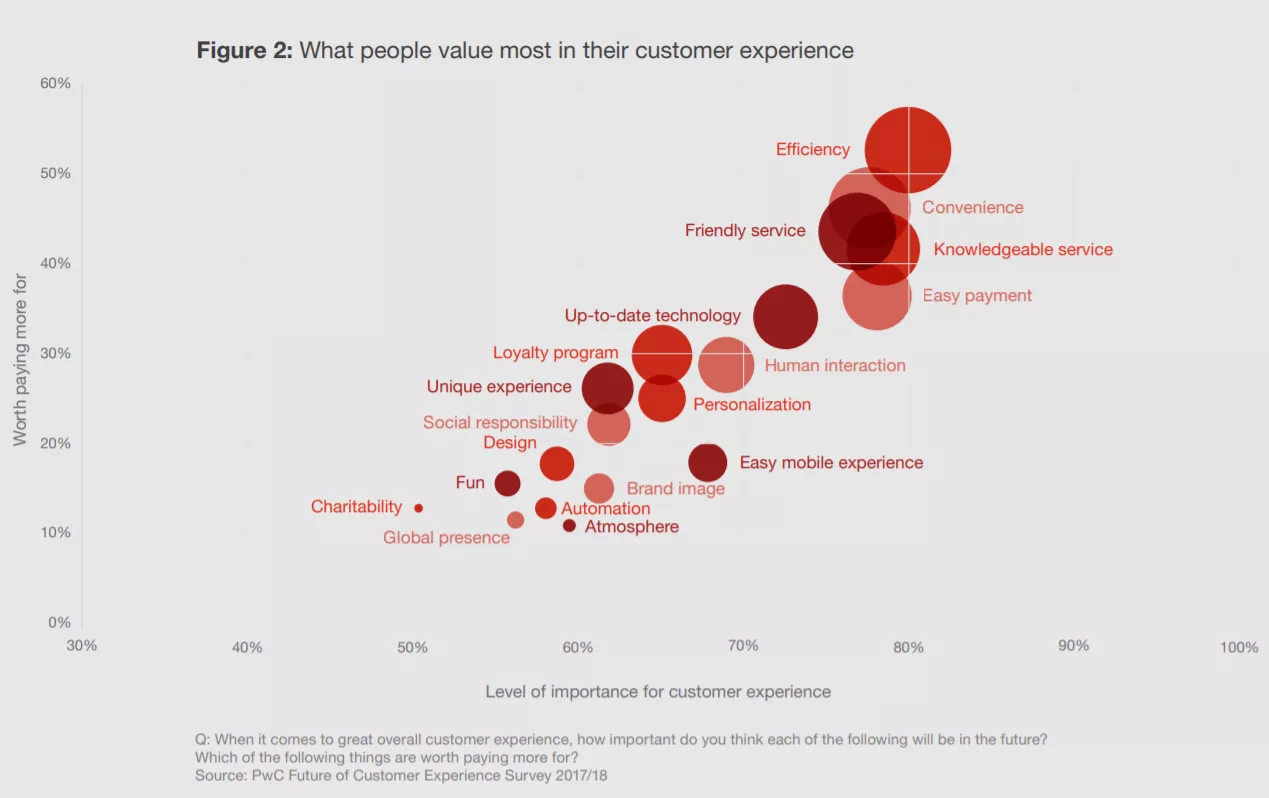
So customer experience is more than just a passing trend. It’s a trend that’ll remain in 2020 and probably in the upcoming years.
Trend #2: Rise of Chatbots
You’ve already seen how chatbots and virtual assistants have been used by more and more businesses to assist their marketing efforts. You’ve seen how chatbots are now popping up on more artificial intelligence-powered websites than ever before. And there are many reasons why chatbots may be a powerful way of using AI-powered technology for marketing.
In fact, research by Global Market Insights shows that the overall market size for chatbots worldwide will be over $1.3 billion by 2024. Pretty impressive, right?
Chatbots are actually now helping to take some of the grunt work out of marketing so businesses can focus on creating strategies and providing great customer experience instead.
But the human aspect of marketing is still important. Chatbots are being used to enhance marketing efforts, not to replace the real people behind them.
In the graph below from Drift, you can see people’s expectations on face-to-face conversations and chatbots nowadays.
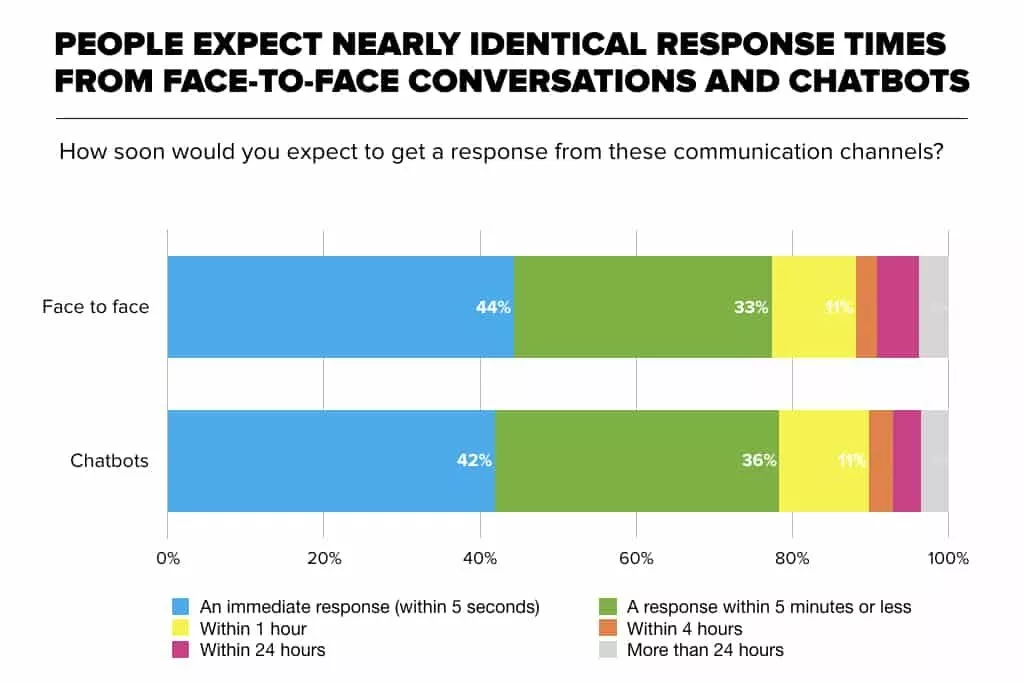
Some other stats from Salesforce show that chatbots are expected to be used by 53% of service organizations over this year.
On top of that, Drift also found that given the choice between filling out a form with an email response or getting answers from a chatbot, only 14% would choose filling out a form.
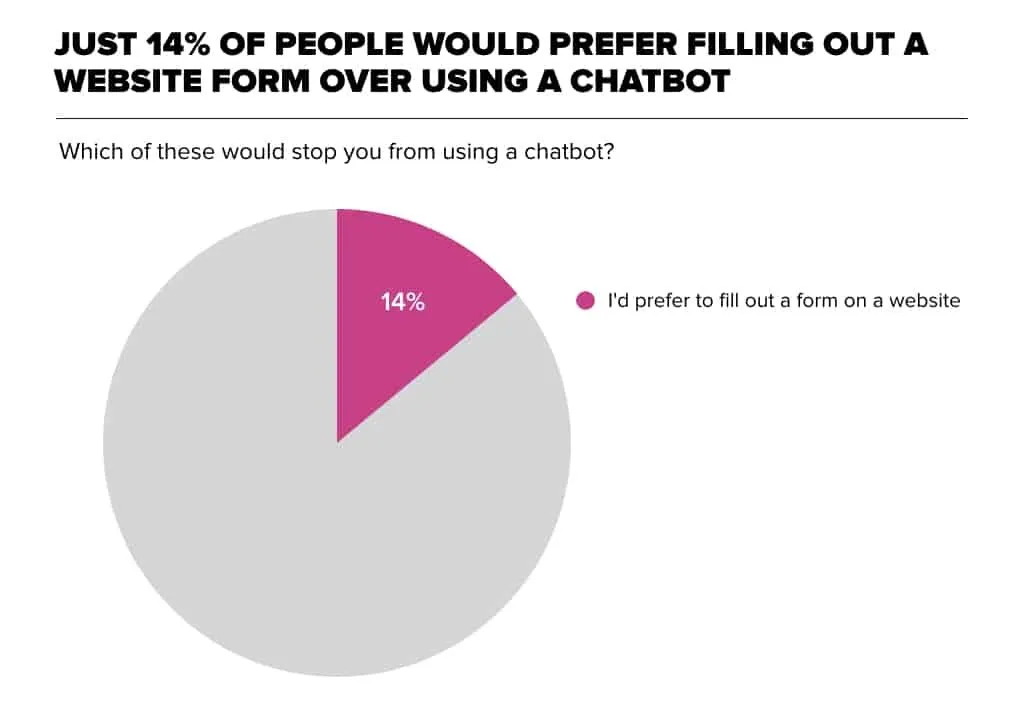
This marketing trend in 2020 shows that chatbots will be much more prepared to match human behavior and offer similar services of human face-to-face communication.
With the rise of technology, bots will become smarter and will understand the conversations with websites’ visitors and their queries.
But using chatbots for communication has its downsides too. Chatbots may still misinterpret a site’s visitors requests because they’re not able to fully understand the intent of the customer. Also, they tend to misunderstand the nuances of human dialogue because they can’t recognize all accents or cultural dialects.
So while chatbots represent a new technology for consumers, most companies should innovate in this area. Because as the study by Drift shows in the graph below, 23% of the people surveyed would use chatbots for even paying bills.
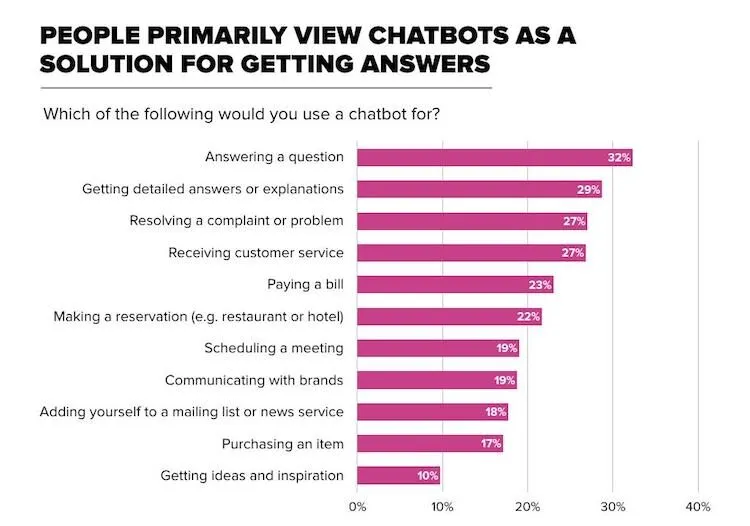
Trend #3: Marketing Will Be Personalized
If you want to stand out in 2020 from the competition, you need to personalize your marketing. This means you need to personalize content, products, emails and everything else you offer consumers.
And marketing personalization doesn’t only mean automatically changing the name of the person you’re sending your email newsletters to. It’s more than that.
The rise of AI combined with increased data collection and insights from social media and other sources have definitely made it possible to personalize content, design, product recommendations, etc.
Nowadays, consumers receive so many marketing messages from multiple channels. And this can be overwhelming. That has made traditional advertising lose its effectiveness because if consumers don’t get the right messages, the relationship won’t be nurtured. But with personalized marketing messages that forge a real connection between your brand and the right target market, consumers are more likely to identify with you.
As a matter of fact, research by Epsilon says that 80% of consumers are more likely to do business with a brand that provides a personalized experience.
And here are some other shocking stats from Epsilon about the importance of marketing personalization for some specific industries:
- 90% of the people surveyed say they’re more likely to do business with grocery/drug store websites/apps offering personalized experiences. Only 71% say grocery/drug store websites/apps are currently delivering personalized experiences well.
- 87% of respondents say they’re more likely to do business with travel websites/apps that offer personalized experiences. Only 64% say travel websites/apps are currently delivering personalized experiences well.
- 86% of respondents say they are more likely to do business with automotive websites/apps that offer personalized experiences. Only 55% say automotive websites/apps are delivering personalized experiences well.
So, even though consumers are constantly blindsided by so many marketing messages everywhere, your message should fulfill every single prospect’s need. And through personalization, you’ll easily convert leads into loyal customers instantly.
A good example of what I’m saying is Amazon. When you search for a specific item, they show you what they think you’ll like. And they do this to boost their conversions. They know your patterns and likes based on your search history and turn that into a customized offer.
If you log into your Amazon account now, you’ll see that items displayed match your likes. You’ll probably be persuaded to buy some of those items because you’ll feel like the company actually cares about you, knows you, and took the time to give you a list of suggestions you might like.

This also happens with Netflix and their recommended movie titles that match your likes and expectations.
By providing a personalized experience to your prospects, you’ll be offering the best options for them—exactly what they want.
Customers are able to get what they need instead of browsing endless options of products that they couldn’t care less about.
Trend #4: The Focus Will Be on Generating Great Content
John Mueller, Webmaster Trends Analyst at Google says that “rather than chase the latest SEO trends, it’s more important to ensure a site has fast speeds, useful links, and well-written content.” And that’s exactly what this trend is all about.
Generating good content will be the priority in 2020 instead of posting bland articles that don’t teach anything to readers.
When it comes to content marketing, don’t just post a blog and share it on social media. Content is much more than just posting. It’s about teaching your readers, making their reading experience as pleasant as possible, and sharing high-value content.
In fact, content marketing is so valuable that according to research by PointVisible, 88% of B2B content marketers agree that generating great content makes their audience view their organization as a credible and trusted resource.
In 2020, marketers will keep creating marketing strategies to make sure that the right message is delivered to the right audience at the right time.
For instance, some stats from Content Marketing Institute show that:
- Content marketing costs 62% less than outbound marketing and generates 3x as many leads.
- Content marketing has lower up-front costs and deeper long-term benefits than paid search.
- Small businesses with blogs generate 126% more leads than those without blogs.
- Content marketing rakes in conversion rates 6x higher than other methods.
In 2020, high-quality content will keep allowing you to show your expertise and communicate with your site’s visitors. That’s what we always do at Growbo. Speaking of, we’re looking to hire some new team members. So drop us a line if you’re interested in joining the team!
And remember, your content is what search engines like Google provide to searchers online, not your keyword density. So keep generating high-quality content this year.
Trend #5: Companies Will Optimize for Voice Search
The smart speaker business is booming. Research by Nielsen shows that 90% of smart speaker users use their devices to listen to music on the speaker in a typical week, while 68% listen to the news and 80% search for real-time information.

Voice search will continue to be a major influence on how brands create content and market themselves online this year.
A study by PwC says that 10% of surveyed respondents were not familiar with voice-enabled products and devices. That means that 90% are already using them.
And besides using smart speakers like Alexa, Microsoft’s Cortana, or Google Home to answer users’ questions and play music, popular brands can leverage these devices to provide voice-service for their users.
Even if your brand isn’t ready for smart speaker advertising, it’s important that your content is optimized for voice search.
A study by WordStream shows that the increasing use of voice search has made it important for companies to rethink their digital marketing strategies in 2020...
- 50% of all searches will be via voice by 2020.
- 55% of all American homes will own a smart speaker by 2022.
- Voice shopping is set to jump to $40 billion in 2022, up from $2 billion today.
- Global smart speaker shipments have almost tripled between Q1 2018 and Q2 2019, growing from 9.36 million units to 26.1 million units.
- 72% of people who own voice-activated speakers say that their devices are used as part of their daily routines.
- 52% of people keep their voice-activated speakers in their living rooms, per Google. 25% keep them in their bedrooms, while 22% keep them in their kitchens.
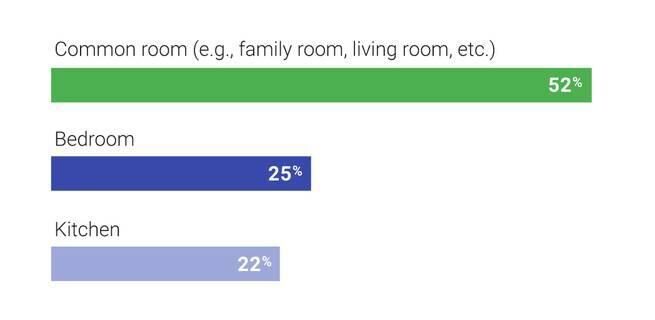
Whether you like it or not, if you’re a business owner who sells online, you can now turn your product catalogs into voice-enabled marketplaces and let your users place orders with very simple and clear voice commands.
But what companies need to realize is that voice search isn’t another channel to force messaging and sales. Marketers must strengthen consumer interaction with a more connected brand experience.
Trend #6: Shoppable Social Media Posts Will Remain Prominent
Social media has become a vital part of online marketing. According to Instagram, the number of active worldwide users now is 1 billion, 90% of them are following shopping brands, and 72% of Instagram users have purchased a product on the app.
Social media platforms like Facebook, Pinterest, or Instagram, offer e-commerce stores the possibility of customers purchasing through shoppable posts. This makes it easy for users to buy directly from a post they come across in their newsfeed.
In March 2019, Instagram launched Instagram Checkout which lets users complete their purchase from within Instagram.

They only click on the item that’s for sale and are instantly redirected to a checkout page.
E-commerce brands hope this will reduce the risk of customers abandoning the purchase process because they have to switch from one app to another one or sign in to an unknown website.
Conclusion
Want to delegate all your marketing and funnel work done—without the headaches of hiring? Download our free guide: 33 Marketing Projects You Can Delegate to Growbo and discover how to save 100+ hours a month, grow faster, and scale without the overhead.
There you go. 6 simple and completely actionable digital marketing trends to follow this year.
If you’re looking for your business to generate more sales, boost conversions, or to thrive and not just survive, you came to the right place. These trends will help you achieve that and more.
We’re heading towards an era where customer service is one of the primary focuses within big companies. Because if you provide excellent customer support and personalized marketing messages, your prospects will come back for more.
Chatbots will keep taking on the responsibility of customer service but maintaining the human aspect of communication is still key. Because consumers want to be heard and understood.
Other digital marketing trends to follow in 2020 are to generate great (not good) content, optimize for voice search, capitalize on the prominence of shoppable social media posts, and of course, AI.
So there you go. 6 easy to follow trends that in a snap can row your boat in the direction you want.
Now tell me something, which of the 6 digital marketing trends do you think you’ll follow after reading this article? Did you follow any trends last year?
Let me know in your comments below.
Keep funnelin’, stay focused.
Mariana













